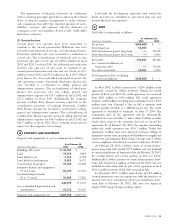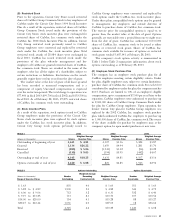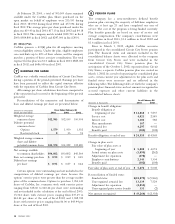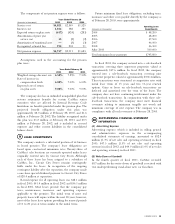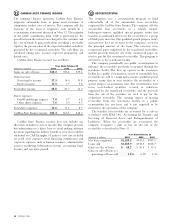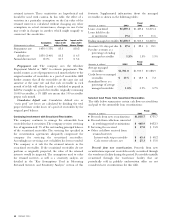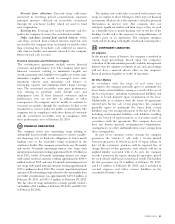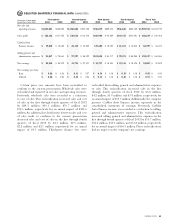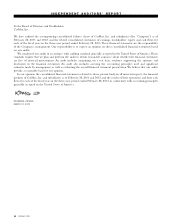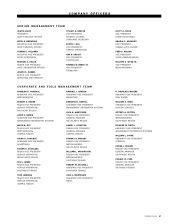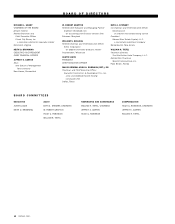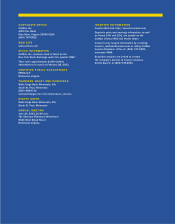CarMax 2003 Annual Report Download - page 46
Download and view the complete annual report
Please find page 46 of the 2003 CarMax annual report below. You can navigate through the pages in the report by either clicking on the pages listed below, or by using the keyword search tool below to find specific information within the annual report.
44 CARMAX 2003
RECENT ACCOUNTING PRONOUNCEMENTS
In August 2001, the FASB issued SFAS No. 143,
“Accounting for Asset Retirement Obligations.” This
statement addresses financial accounting and reporting for
obligations associated with the retirement of tangible long-
lived assets and the associated asset retirement costs. It is
effective for fiscal years beginning after June 15, 2002. The
company does not expect the application of the provisions
of SFAS No. 143 to have an impact on its financial position,
results of operations or cash flows.
In June 2002, the FASB issued SFAS No. 146,“Accounting
for Costs Associated with Exit or Disposal Activities.” This
statement addresses financial accounting and reporting for
costs associated with exit or disposal activities and nullifies the
Emerging Issues Task Force (“EITF”) Issue No. 94-3,
“Liability Recognition for Certain Employee Termination
Benefits and Other Costs to Exit an Activity (including
Certain Costs Incurred in a Restructuring).” SFAS No. 146 is
effective for exit or disposal activities initiated after December
31, 2002.The company does not expect the application of the
provisions of SFAS No. 146 to have an impact on its financial
position, results of operations or cash flows.
In December 2002, the FASB issued SFAS No. 148,
“Accounting for Stock-Based Compensation—Transition
and Disclosure.” This statement amends SFAS No. 123,
“Accounting for Stock-Based Compensation,” to provide
alternative methods of transition for a voluntary change to
the fair value based method of accounting for stock-based
employee compensation. In addition, this statement amends
the disclosure requirements of SFAS No. 123 to require
prominent disclosures in both annual and interim financial
statements about the method of accounting for stock-based
employee compensation and the effect of the method used
on reported results. It is effective for financial statements for
fiscal years ending after December 15, 2002. The company
has revised its disclosures to meet the requirements under
this standard.
In November 2002, the FASB issued FASB Interpretation
(FIN) No. 45, “Guarantor’s Accounting and Disclosure
Requirements for Guarantees, Including Indirect Guarantees
of Indebtedness of Others.” FIN No. 45 requires the
recognition of a liability for certain guarantee obligations
issued or modified after December 31, 2002. FIN No. 45 also
clarifies disclosure requirements to be made by a guarantor of
certain guarantees. The disclosure provisions of FIN No. 45
are effective for fiscal years ending after December 15, 2002.
We have adopted the disclosure provisions of FIN No. 45 as
of February 28, 2003. The company does not expect the
adoption of FIN No. 45 to have a material impact on its
financial position, results of operations or cash flows.
In January 2003, the FASB issued FIN No. 46,
“Consolidation of Variable Interest Entities, an Interpretation
of ARB No. 51.” FIN No. 46 requires certain variable interest
entities to be consolidated by the primary beneficiary of the
entity if the equity investors in the entity do not have the
characteristics of a controlling financial interest or do not
have sufficient equity at risk for the entity to finance its
activities without additional subordinated financial support
from other parties. FIN No. 46 is effective for all new variable
interest entities created or acquired after January 31, 2003.
For variable interest entities created or acquired prior to
February 1, 2003, the provisions of FIN No. 46 must be
applied for the first interim or annual period beginning after
June 15, 2003. The company is currently analyzing the
existing guidance and reviewing any developments with
regard to the proposed FASB Staff Positions issued on the
implementation of FIN No. 46 which are currently subject
to public comment. Therefore, the company cannot
determine whether there will be an impact on its financial
position, results of operations, or cash flows at this time.
In January 2003, the FASB issued EITF Issue No. 02-16,
“Accounting by a Customer (Including a Reseller) for Certain
Consideration Received from a Vendor.” This EITF addresses
the accounting by a vendor for consideration (vendor
allowances) given to a customer, including a reseller of the
vendor’s products, and the accounting by a reseller for cash
consideration received from a vendor. It is effective for certain
arrangements entered into after November 21, 2002, and for all
new arrangements, including modifications to existing
arrangements, entered into after December 31, 2002. The
company adopted the provisions of the EITF in the fourth
quarter of fiscal 2003 and, as the company’s policies were
already consistent with those of EITF 02-16, the adoption of
this standard did not have a material impact on the company’s
financial position, results of operations or cash flows.
15



